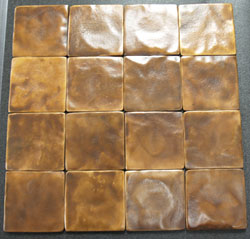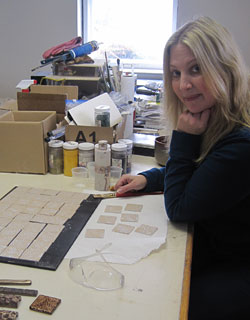Miila Studios: The Warmth of Bronze in Tile
 Bronze Monte Carlo with Stone.
Bronze Monte Carlo with Stone.Photograph courtesy of Miila Studios
Few can say they fell in love in a high-end tile showroom, but this is the story behind Michael Grubb and Laura Getzoff of Miila Studios. The two married 11 years ago and started their joint venture in handcrafted tile-making in 2000, specializing in glass, aluminum and bronze.
Getzoff spent six years working at Charles Tiles in Philadelphia as a sales manager. On the historic day when Grubb walked into the showroom, he shopped for three hours, telling her later that he knew he'd marry her someday. During that initial visit, she explained to him that she was in a relationship.
Grubb stopped back the next year, and luckily for him, she was available, so their relationship began, and those early days revolved around creating tiles for kitchens, bathrooms, floors, furniture, and more.
They each spent time studying at the Corning Museum of Glass in New York, with Grubb staying longer in practicing chemistry, glass casting, mold-making and kiln forming techniques, later teaching Getzoff the majority of what he learned while out of state.
With Grubb's experience in casting, welding, brazing, and fabricating an assortment of metals while laboring alongside his father in a motorsports outfit called J & J Racing Ltd., he thought combining his metalwork expertise and Getzoff's knowledge in the tile industry would lead to a successful undertaking.
"In the tile industry, even if they're not the actual metals, bronze and nickel (or aluminum) are two popular colors for metal or metallic finishes because they go well with hardware," says Getzoff about complementing tones and textures. "Most people have a nickel or bronze finish on their faucets."
 Custom patina bronze field tile.
Custom patina bronze field tile.Photograph courtesy of Miila Studios
With a degree in English and having attended the Tyler School of Art at Temple University in Philadelphia, Getzoff has painted since her childhood. She easily mixes colors in her design efforts and takes her brushstrokes to the glass tiles often combined with the weighted and authentic metal tiles in their collection.
"If architects or designers falls in love with our material, they can convince clients that it's worth the expense to have something that's interesting, handmade, unique, one-of-a-kind-a real, solid material as opposed to some type of adulterated plastic," Getzoff says. "In the tile industry, a lot of the metal tiles are not metal. They're an epoxy with some type of bonded metal finish----so they're plastic, basically."
Getzoff has gleaned through her clientele spanning across the country and the globe, too, that some people genuinely appreciate the artistry going into tiles made at Miila Studios, happy to support artists in the U.S. instead of buying mass-produced materials from a factory.
When designing tiles, Getzoff often considers the popular colors of wood in cabinets and admires how bronze orchestrates very smoothly with those finishes. She especially likes how the earthy tones of browns, creams, and burnt oranges of granite countertops reflect well when in close proximity to bronze tiling.
"If you feel it, it's very substantial," Getzoff says about their bronze products in contrast to assembly-line made tiles on the market today. "It has a nice smooth, heavy weight, and it feels good."
Grubb designs the tile patterns in his metalwork room in the studio, then sends them to Mingo Non-Ferrous Metals for casting. While some tiles are straight bronze, a few have pockets built into them to hold fired glass, which is secured with pure silicon glue, a reliable bonding agent they began using years ago.
 Laura Getzoff at Miila Studios.
Laura Getzoff at Miila Studios.Photograph courtesy of Miila Studios
Their metals are treated with different hues of patina finishes as a solution bringing a naturally aged look to their surfaces, with bronze consistently outselling their aluminum tiles two-to-one, Grubb says.
"It's a unique combination, and it appeals to people," Getzoff said about juxtaposing bronze and glass in tile work.
He then grinds, sands, buffs, and polishes the surfaces to bring out the brightness of the bronze again while still keeping the tiles authentically antiquated in appearance, with patinas accelerating the aging process in the outer layer of the metal. After applying the patinas, Grubb again smoothes the surfaces to let some of the original bronze shimmer through, away from the more shadowy sections.
Their 4' x 4' Moonflower tiles, along with their 5/8'' x 8'' Moonflower pencil, brought to life in light throws of shallow dips in shape with the heat of a torch, often used to border along a backsplash at a kitchen sink and countertop expanse, are a shining example of the authentically old lure offered eye-wise through application of their black-brown patina.
Aside from and sometimes with custom orders, Miila Studios offers several sets of bronze tiles mostly in the 4' x 4' size, while a Barcelona is 2' x 2' and combines gleaming metal with pocketed glass. Milan, Monte Carlo, Spirograph, Split Rock, and Hammered are others in their usual line.
The tiles, especially those married with glass, incorporate variation, as Grubb and Getzoff value the integrity of a more organic beauty possible in each tile. And when Getzoff paints select pieces, she considers each tile her own small canvas.
"Bronze accepts patinas very well, and you can really help a client match their hardware, like cabinet pulls, because it blends nicely," Getzoff says. "Bronzy tones are very popular right now in hardware. It's a natural look and can be traditional and modern at the same time."
"It goes with just about anything and is almost neutral. In a lot of homes, people like warmth in their decorative accessories," Getzoff continues. "There are some people who want to go contemporary, and we sell more aluminum to those who want a more modern look. Bronze is versatile in that we can apply many different patinas, which offers a wide color palette. It has tremendous corrosion resistance, so it is a natural fit for bathrooms and showers," Grubb says about what makes it a successful tile material. "It has great wear-resistance, so it is often used in floors. It also withstands high temperatures, so it's a popular choice for fireplace surrounds."
 Bronze hand cast Moonflower tile.
Bronze hand cast Moonflower tile.Photograph courtesy of Miila Studios
Some of Miila Studios corporate clientele include W. L. Gore & Associates, Inc., makers of Gore-Tex waterproof breathable fabric, Samsung in South Korea, Hearst Castle, a mansion serving as a historic landmark on the national level along California's central coast, and Charming Square, a 10-story retirement community in Tokyo, Japan.
With a lot of their tiles as custom designed sets for private clients, they've done work for the famed Wyntoon Estate of William Randolph Hearst along the McCloud River in California and several private estates across Martha's Vineyard.
Grubb estimates that he makes about 5,000 bronze tiles each year between different projects and product lines, with distributors in 16 different states. The tiles are also sold on FastFloors.com.
Selections of their tiles have also been featured on HGTV and DIY television networks.
Getzoff says she enjoys knowing that all across the country, homes here and there are peppered with the art made from the heart by her and Grubb, finding this warmth well in line with the warmth she loves in bronze.
"You could make a case for it being a very old metal in the history of use," Getzoff says in referencing bronze's illustrious popularity thousands of years ago. "There's something interesting about the fact that we're still using it, and instead of making Bronze-Age weapons, we're making tiles with it."
Resources:
Also in this Issue:
- Miila Studios: The Warmth of Bronze in Tile
- Nicholas Yust: Fine Metal Art from Both Sides of the Brain
- The Standard Grill: Simple Copper Pennies Create An Extraordinary Floor
- Hearing the Call of Nature
- Park Avenue Armory Renovation unveiled by Herzog and De Meuron
